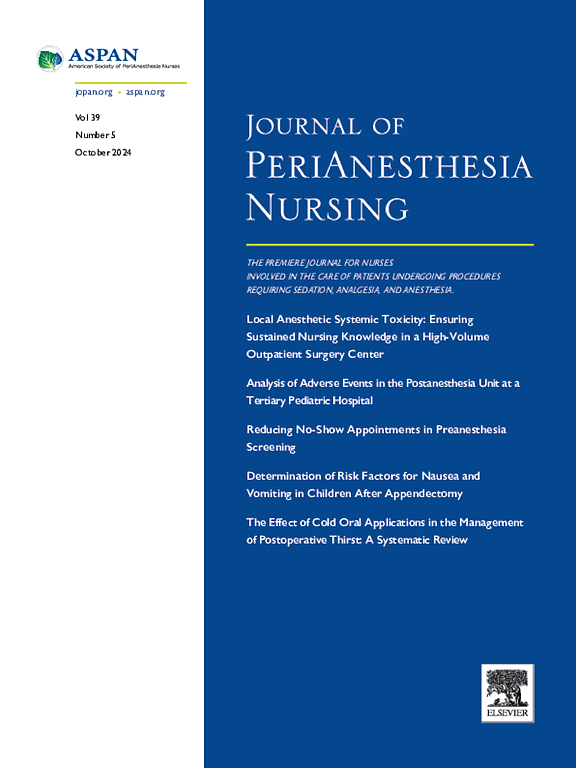术前恐惧程度会影响母乳喂养吗?
IF 2
4区 医学
Q2 NURSING
引用次数: 0
摘要
目的:探讨手术恐惧、母乳喂养开始时间和母乳喂养自我效能感之间的关系。设计:本研究为描述性研究。方法:研究对象为2024年7月至10月在市医院妇科外科及产后服务部门申请择期剖宫产手术的患者。研究样本包括符合资格标准并同意参与的孕妇。采用介绍表、母乳喂养评估表、手术恐惧量表和母乳喂养自我效能量表收集数据。结果:短期恐惧量表与长期恐惧量表存在中度正相关,手术恐惧量表及其量表与母乳喂养自我效能量表存在中度负相关(P≤0.001)。25岁及以下女性母乳喂养自我效能量表平均得分较低,组间差异有统计学意义(P)。结论:本研究提示,剖宫产术中女性的母乳喂养问题不应仅关注因手术困难导致的母乳喂养问题,而应在术前考虑。建议调查干预措施的效果,以减少术前手术恐惧对母乳喂养的影响。本文章由计算机程序翻译,如有差异,请以英文原文为准。
Does Preoperative Surgical Fear Level Affect Breastfeeding?
Purpose
The purpose of this study was to explore the relationship between surgical fear, breastfeeding initiation time, and breastfeeding self-efficacy.
Design
The research is a descriptive study.
Methods
The population of the study consisted of patients who applied to City Hospital Gynecological Surgery and Postpartum services for elective cesarean section between July and October 2024. The study sample included pregnant women who met the eligibility criteria and consented to participate. Introductory Form, Breastfeeding Assessment Form, Surgical Fear Scale, and Breastfeeding Self-Efficacy Scale were used to collect the data.
Findings
A moderate positive correlation was observed between the short-term and long-term fear subscales, while a moderate negative correlation was found between the Surgical Fear Scale and its subscales and the Breastfeeding Self-Efficacy Scale (P ≤ .001). Women aged 25 years and younger had lower mean Breastfeeding Self-Efficacy Scale scores and the difference between the groups was statistically significant (P < .001). The mean scores of the subscale and total scale of the Surgical Fear Scale were lower, the mean scores of the Breastfeeding Self-Efficacy Scale were higher, and the difference between the groups was statistically significant (P ≤ .001, P = .002, P = .001, P ≤ .001, respectively). The subscales and total scale scores of the Surgical Fear Scale of working women were lower and the difference between the groups was statistically significant (P = .005, P ≤ .001, P ≤ .001, P ≤ .001, respectively). The mean scores of the subscales and total scale of the Surgical Fear Scale were higher, the mean scores of the Breastfeeding Self-Efficacy Scale were lower, and the difference between the groups was statistically significant (P = .001, P ≤ .001, P ≤ .001, P ≤ .001, P ≤ .001).
Conclusions
This study shows that breastfeeding problems in women undergoing cesarean section should not only be focused on breastfeeding problems due to the difficulties caused by the surgery, but should also be taken into consideration in the preoperative process. A recommendation is to investigate the effect of interventions to reduce the effect of preoperative surgical fear on breastfeeding.
求助全文
通过发布文献求助,成功后即可免费获取论文全文。
去求助
来源期刊

Journal of Perianesthesia Nursing
NURSING-
CiteScore
2.20
自引率
17.60%
发文量
279
审稿时长
90 days
期刊介绍:
The Journal of PeriAnesthesia Nursing provides original, peer-reviewed research for a primary audience that includes nurses in perianesthesia settings, including ambulatory surgery, preadmission testing, postanesthesia care (Phases I and II), extended observation, and pain management. The Journal provides a forum for sharing professional knowledge and experience relating to management, ethics, legislation, research, and other aspects of perianesthesia nursing.
 求助内容:
求助内容: 应助结果提醒方式:
应助结果提醒方式:


